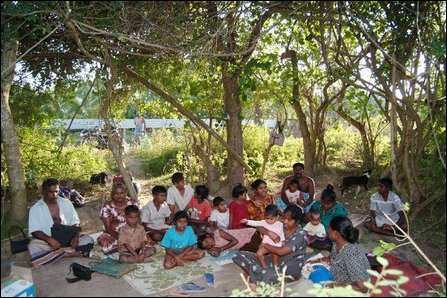
Kanakapuram bombings
[TamilNet, Sunday, 20 January 2008, 10:20 GMT]
Statistics compiled by social service groups in Kilinochchi reveals 67 civilians belonging to 17 families have been affected by the aerial bombardment when four Sri Lanka Air Force (SLAF) fighter jets dropped bombs 100 meters away from Kanakapuram Maha Viththiyaalayam school in the Ki'linochchi suburb Thursday morning. The group includes 26 infants and young children, a polio victim, and 16 civilians previously displaced from Va'ra'ni in Jaffna District and living in the vicinity of the school.

Nithyakumar Ranjani, mother of an infant

Manickam Rasamany (58)
Recounting the horror perpetrated by the Sri Lanka Air Force (SLAF) warplanes in Kanakapuram, a civilian area and a suburb of Ki'linochchi town, Thursday morning, a Nithyakumar Ranjani, a young mother of an infant said "I have a one year old child and on the day of the SLAF attack, I was bathing my child. At that time I noticed a spy air craft circling in the skies above causing a lot of anxiety and fear. My husband was not at home at that time since he had gone to work.
"Sensing danger, I rushed bathing my child but meanwhile I heard the sound of approaching fighter jets. I stopped bathing and took the child with me and rushed into the bunker.
"Bombs began to fall close to our house soon after we entered the bunker, and I heard a deafening explosion that shook the grounds. Huge lumps of sand from mud walls and shrapnel from the bombs were raining on us inside the bunker.
"My child started screaming, I slightly raised my heard to see what was happening and I saw the entire area filled with black smoke. I then recollected myself and fled out with my child out of the bunker," Ranjani said.
Manickam Rasamany, 58, a grandmother describing the days events said, "as soon as we saw recon-aircraft in the skies, my two grand children started trembling with fear, and I placed both of them on my lap to pacify them.
"Meanwhile, the Kfir aircraft ame above and started dropping the bombs. I placed my grand kids on the ground and I also lied down near them. Immediately after the bombs were dropped, I rushed into the bunker.

Kanakarpuram Kfir bomb victims are living among the shrubs in this desolate area.
"Just after we sought safety in the bunker, the bomb exploded bringing in huge lumps of mud sand and pieces from the exploded bomb that fell upon my grand children covering them. When I came out of the bunker I found the area deserted and there were no one else except us. I heard screams at a distance and then we fled from the area.
"Since that day, we have not gone back to our home but we are living among the shrubs in this desolate area. Our schools in the vicinity were targeted by the bombers. As such how can we think of seeking refuge in schools or temples? We are forced to eke out our existence, the worried grand mother said.

Kanakarpuram Kfir bomb victims are living among the shrubs in this desolate area.
"In 1997, when SLA troops captured Ki’linochchi, we were displaced from our homes and underwent similar hardships. We moved to a number of places including Akkaraayan, Union kulam, and Koa'naavil. When the area was recaptured by LTTE we returned to Ki’linochchi, and once again started living in our home. Now we are again displaced and scared to go back to our home.
"We feel like taking our lives but are forced to continue living because of our children," Rasamany said.
790 schoolchildren and 22 teachers at the Kanakapuram Maha Viththiyaalayam School also escaped near death when SLAF fighter jets dropped bombs near the school.
A repeat of the Chenchoalai massacre was avoided as civilians sought shelter inside bunkers, managed to flee the area and anti-aircraft fire disturbed the SLAF mission, according to locals who witnessed the chaos Thursday.
One civilian who sought safety inside a bunker was wounded and succumbed to his injuries. Seven civilians were wounded in the SLAF attack. Nine houses were damaged in the bombardment and Six homes were reduced to rubble in the aerial attack.
A few of the affected have managed to find temporary accommodation in the homes of their relatives and friends. Few governmental or Non Governmental Organizations (NGOs) have come forward to assist the civilians.
Chronology:











